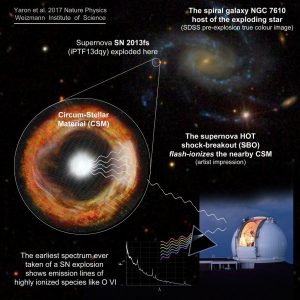Mexico City, Mar 1 (EFE).- A group of international scientists announced on Tuesday it had detected the earliest stages yet of a massive star explosion resulting both in a supernova and in the largest gamma-ray burst ever detected.
This early detection enabled the researchers to clearly observe the star’s ejected material in its final death throes.
According to physicist Dr. William Lee Alardin, the explosion was detected in Oct. 2013 by the Mount Palomar observatory in California (United States) and their calculations suggest it took place in a galaxy 160 million light years distant from our own Milky Way galaxy.

A light year is the distance covered by light in vacuum at a speed of almost 300,000 km per second (aprox. 186,000 mps) in one year.
The star, possibly a red giant in the spiral galaxy NGC 7610 (Leo constellation,) and the resulting massive gamma-ray burst event was designated GRB 130427A prior to the formation of its supernova (SN 2013fs) stage.
This event produced the highest-energy light ever detected and was tracked some three hours after it happened, which enabled it to be followed in real time by part of Earth’s global telescope network.
Gamma-ray bursts are the universe’s brightest explosions currently known and were discovered as recently as 1967.
Astronomers think most massive GRBs and subsequent supernova happen when a massive star runs out of nuclear fuel and collapses under its own weight.
As the core collapses, jets of material shoot outward from both of its poles, at nearly the speed of light.
Among those who responded to the GRB 130427A alert was the Harold L. Johnson robotic telescope of the National Astronomical Observatory in San Pedro Mártir, in Mexico’s state of Baja California, managed by the Institute of Astronomy of the Universidad Nacional Autónoma de Mexico (UNAM).
The observation was well-coordinated across the international astronomical network, including Israel, Denmark, Ireland, Sweden, the United Kingdom, US and Mexico, said Alardin, who works as scientific research coordinator at the UNAM, during an interview with EFE.
“Once we pinpointed the object’s location, the Reionization and Transients Infrared Camera (RATIR), a four-channel simultaneous optical and near-infrared imager mounted on the 1.5-meter Harold L. Johnson Telescope, was able to monitor the event during four months,” Alardin explained.
Alardin, a Physics graduate of the Faculty of Sciences of the UNAM and a 1998 Ph.D. in Physics from the University of Wisconsin, Madison, explained that the imploding star “was between ten and 20 times the mass of our Sun” and the explosive GRB event resulted in a Type II Supernova identified as SN 2013fs.
The astronomer explained that a supernova is an astronomical event that occurs in the final evolutionary stages of a massive star’s life, whose sudden and catastrophic destruction is marked by one final massive explosion of ejected material that settles around the dying star into a massive CSM (circum-stellar material) ring cloud expanding outwards.
The resulting supernova light blast can shine for weeks or months until it slowly fades out of sight.
According to Alardin, the telling signs of an imminent supernova event possibly took place one or two years before the explosion, a very short timeframe if compared to the overall lifespan of this type of star, which can last some 10 million years (one thousand times less than the lifespan of our own Sun, a G3 star.)
As the event was captured at such an early stage, the researchers were able to observe the ejected material surrounding the star before the explosion itself caught up with the ejecta.
Other researchers were able to witness this phenomena days after it happened; therefore, this hours-only early detection represents one of the best supernova observations to date.
Alardin also noted that the state-of-the-art instrumentation capable of automated event-response makes these discoveries possible.
“We would have been unable to capture this event with technology dating twenty years ago,” he said.
Although the explosion was detected in 2013, the supernova analysis and study has only been recently completed.
The study was led by Ofer Yaron, from Israel’s Weizmann Institute for Science, who co-authored an article in the Nature Physics journal on Feb. 13, 2017, supported by a multinational team of researchers.
The way forward, Alardin explained, is to “try to detect these events in their very first stages, immediately in the wake of the explosion” to learn more about the different stages of a star’s life.
“These are ongoing programs and we hope to find these events even sooner,” added Alardin.
